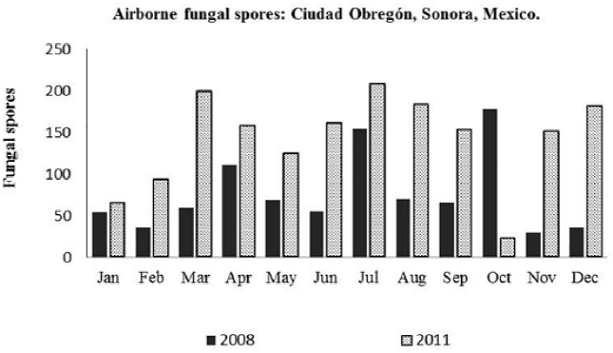Introduction
Fungi are the most abundant microorganisms in the air because they are present in all habitats (Rojas et al., 2007), and they can originate from various sources related to human activity such as livestock husbandry, fermentation processes, industrial and agricultural activities, and waste management as well as biological processes that occur in nature (Rosas et al., 1996; Hammed and Awad, 2004). Because of their size and morphology, spores propagate and disperse readily in the air; some concentrations can cause respiratory allergies in humans. In Mexico City, 42% of medical consultations are related to some type of allergy (López-Pérez et al., 2009). D'Amato et al. (1997) indicate that the primary fungal spores that trigger respiratory allergic reactions in Europe are Alternaria and Cladosporium, which are the most abundant fungi in indoor and outdoor environments (Pontón et al., 2002; Aira et al., 2006). The most common and abundant airborne fungal spores reported for Mexico City are Cladosporium, Aspergillus, Alternaria, Ulocladium, Geotrichum, Penicillium and Physarum (Rosas et al., 1990; Ríos-Yuil et al., 2012). However, the different spore taxa that are present in the air, their concentrations, and their propagation directly depend on the geographic region, the meteorological parameters and climatic conditions, the land use and vegetation type of each locality, and the air pollution level (Hammed and Awad, 2004; Ponce-Caballero et al., 2010).
Sonora is a northwestern state in Mexico. It is the second largest state, and it exhibits 24 different types of weather (from very dry and warm, particularly at the northwestern part of the state, to semi-cold subhumid in the elevated regions of the Sierra Madre Occidental, to the east), and it primarily hosts 7 types of vegetation (desertscrub, thornscrub, grassland, oak forest, pine and oak forest, conifer forest, and tropical deciduous forest), with desertscrub being the most dominant (Brito-Castillo et al., 2010; Felger et al., 2001). This diversity of environments and the large size of the state provide high potential for fungal diversity (Esqueda et al., 2010). Agriculture is an important economic activity of this state, and there is evidence that rural agricultural areas have the highest concentrations of fungal allergens (Adhikari et al., 2004). The Yaqui Valley is in the southern part of Sonora, and agriculture is one of the predominant economic activities. The Yaqui Valley houses the second-most populated city of the state, namely Ciudad Obregón, with more than 400,000 inhabitants (INEGI, 2010). Within this context, it is important to identify the aerobiological particles (fungi) and to define their allergenic potential, considering that at least 20% of the Sonoran population suffers from some type of allergy (Monteverde, 2015). In this first study on the aeromycota of Sonora, the airborne fungal diversity of Ciudad Obregón will be determined and quantified in two periods: January-December 2008 and 2011 (two contrasting years in terms of precipitation and winter temperature), and its correlation with different meteorological parameters will be established.
Materials and methods
Ciudad Obregón is located at 27° 29' N, 109° 56' W, and 40 meters above sea level (Figure 1). Its primary economic activities are livestock farming and agriculture, mostly through the cultivation of wheat, corn, sorghum, cotton, and vegetables, on an area of 4,500 km2 (Yaqui Valley).
The weather is hot and arid and is classified as BW (h') w (e'), according to the Köppen climate classification (García, 1973). The mean annual temperature is 23°C, with a maximum of up to 45°C in August and a minimum of 6°C in December. The average relative humidity is 60%, with a minimum of 32% and a maximum of 87% (Agroson, 2014). Precipitation is concentrated during the following two periods: 70% between July and September and 30% between December and January, with an annual average of 350 mm (INEGI, 2005); during our study, precipitation began in mid-June and lasted until December.
Sampling was performed with a Burkard 7-Day Recording Volumetric Spore Sampler (Hirst-type) that was located on the roof of building 500 (10 m elevation) at the Sonora Institute of Technology (main campus) during two periods: from January to December of 2008 and 2011. All samples were analyzed according to the protocols from the Spanish Aerobiology Network (Galán et al., 2007) by performing four horizontal sweeps for the identification and quantification of fungal spores. Daily concentrations of fungal spores were calculated by multiplying the daily number of spores by a correction factor (0.54) and expressed in fungal spores/m3, and the monthly fungal indices were calculated by adding the daily spore concentrations and expressed in fungal spores. The correction factor was obtained considering the air suction volume of the sampler and the microscope field of view (Galán et al., 2007). To calculate this factor, the total daily sampled surface was divided by the analized surface and by the daily suction volume. Photo galleries of various collections were used for identification as follows: AeroUEX Aerobiological Information in Extremadura (www.aerouex.es), CEI Labs (www.ceilabs.com) and Ochsner Healthcare With Peace of Mind (www.ochsner.org).
Monthly meteorological data from the Network of Meteorological Stations of Sonora (Agroson, 2014) were obtained for 2008 and 2011. Statistical corrections were performed with Sigma Plot 11.0 (Spearman Rank Order Correlation with 95% confidence) between the monthly indices of the most representative fungal spores and the monthly values of the meteorological parameters (average temperature, maximum temperature, minimum temperature, average relative humidity, maximum relative humidity, minimum relative humidity, precipitation, wind speed, maximum wind speed, average solar radiation, and maximum solar radiation) by accounting for two seasons, namely the dry season (January to May) and the wet season (June to December) during both sampling periods.
Results
The total annual fungal content for 2008 was 917 fungal spores, with maxima occurring in April, July and October. For 2011, the annual total was 1,690 spores, and the peaks were recorded in March, July, August and December, reaching monthly indices of up to 200 spores (Figure 2).
A total of 27 fungal types were found. Most genera represented 0.5 to 0.79% of the annual total, as the following: Beltrania, Bispora, Botrytis, Cerebella, Chaetomium, Epicoccum, Erysiphe, Phoma, Pleospora, Talaromyces, Torula, Ulocladium, Venturia, and other ascospores (Div. Ascomycota), as well as Boletus and Coprinus (Div. Basidiomycota). Aureobasidium, Memnoniella and Nigrospora (Div. Ascomycota), and Rhizopus (Div. Zygomycota) had values of 1 to 2.5% of the annual total. Table 1 only shows the most representative spores, and the analysis only emphasizes these genera (Alternaria, Cladosporium and Aspergillus/Penicillium, Div. Ascomycota) by virtue of being the most abundant genera relative to the rest of the fungal content (likewise, other studies show that these three types are very abundant in indoor and outdoor environments), and because of their importance as allergic response triggers (De Ana et al., 2006; Damialis et al., 2015). Also included in Table 1 are Curvularia, Fusarium (Div. Ascomycota) and Mucor (Div. Zygomycota), representing 1 to 2%, and Drechslera (Div. Ascomycota) with 4 to 5% of the annual total.
Table 1: Most representative fungal spores in the atmosphere of Ciudad Obregón, Sonora, Mexico in 2008 and 2011
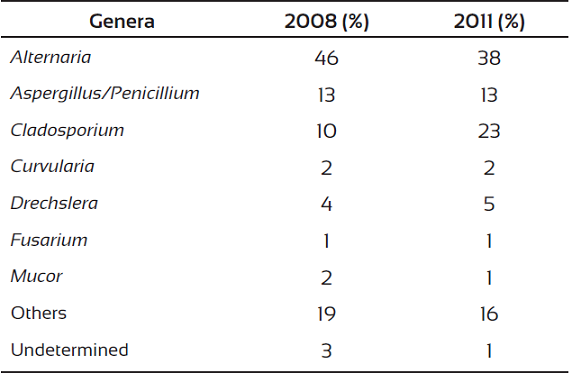
Figure 3 shows the daily fungal spore concentrations from 2008 and 2011 for the most abundant genera. Alternaria was present at all times during the entire year, with a maximum daily concentration on July 25, 2008 of 33 spores/m3, and a second maximum on January 24 (18 spores/m3). In 2011, the maximum concentrations of Alternaria occurred during the wet season, as for 2008, but at lower concentrations; the following maximum daily values are exhibited: November 22 and December 24 (19 spores/m3), July 22 (17 spores/m3), September 2 (16 spores/m3), and August 9 (13 spores/m3).
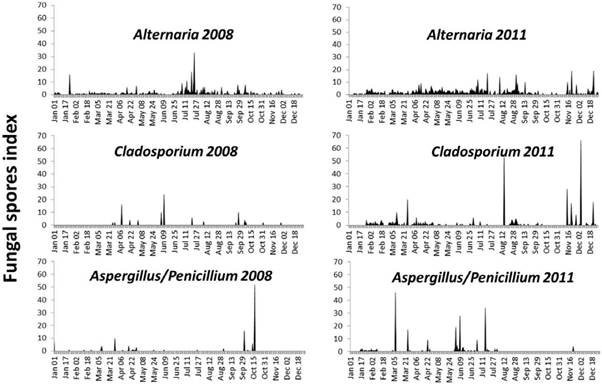
Figure 3: Daily dynamics of the most representative fungal spores in the atmosphere of Ciudad Obregón, Sonora, Mexico.
Unlike Alternaria, the presence of Cladosporium in the air from Ciudad Obregón was not homogeneous. The maximum concentrations of Cladosporium for 2008 were registered during both wet and dry seasons, on June 10 (24 spores/m3), April 9 (16 spores/m3) and September 27 (10 spores/m3). The concentrations were higher in 2011 than they were in 2008, and the highest concentration was observed during the wet season (Figures 3 and 4), with maximum concentrations occurring on December 6 (66 spores/m3), August 16 (54 spores/m3) and November 16 (28 spores/m3), and secondarily during the dry season on March 28 (20 spores/m3).
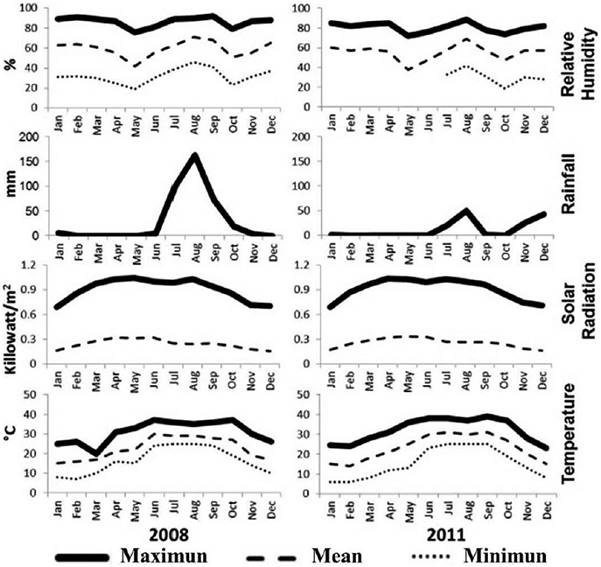
Figure 4: Monthly meteorological parameters at Ciudad Obregón, Sonora. Mexico. January - December 2008 and 2011.
The presence of Aspergillus/Penicillium was also discontinuous throughout the year. This spore type was present in 2008, especially in the mid-wet season, exhibiting a maximum concentration (52 spores/m3) on October 19, as well as during the spring at low concentrations. Conversely, in 2011, the maximum concentration occurred during the dry season on March 8 (46 spores/ m3). The next two maxima occurred on June 18 (28 spores/m3) and at the beginning of the wet season on July 17 (34 spores/m3).
The meteorological parameters for 2008 and 2011 are shown in Figure 4. In 2008, the rain started mainly in mid-June and ended at the beginning of November (386 mm of annual precipitation), but it is important to note that a minimum volume was recorded for January, and that, at the end of the previous year, in December of 2007, 50 mm of precipitation were recorded. By contrast, the annual precipitation in 2011 was only 140 mm. In 2008, the maximum daily temperature was recorded on June 29 (41.7°C) and the minimum daily temperature on January 21 (2.7°C). Relative humidity maximum was 100% on January 30, while the minimum was 7% on May 11; this same day recorded the maximum solar radiation. In 2011, the maximum daily temperature was recorded on two consecutive days: September 18 and 19 (41.4°C), while the minimum temperature was on February 03 (-1.8°C). Relative humidity maximum was recorded on April 04, November 14 and November 17 (95%), while the relative humidity minimum occurred on July 15 (7%). Solar radiation daily maximum was recorded on August 07.
The fungal monthly indices of Alternaria, Cladosporium and Aspergillus-Penicillium were analyzed in conjunction with the monthly averages of meteorological parameters (Table 2). The results show different correlation patterns for the two study years and for the three fungal types. Aspergillus/Penicillium spores show mainly low and not significant correlations with most meteorological parameters. On the other hand, for total spores, Cladosporium and Aspergillus/Penicillium, the data show overall positive correlations with the temperature and solar radiation (except for Cladosporium during the wet season 2011). High correlations were obtained, although they are not always significant (Table 2).
Table 2: Spearman Rank Order Correlation (*P<0.05). Monthly fungal spore indices and monthly meteorological parameters in 2008 and 2011, for Ciudad Obregón, Sonora, Mexico
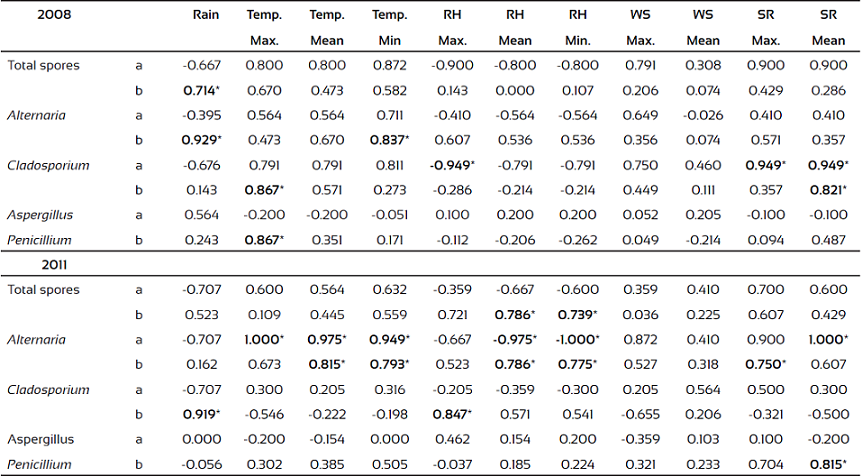
a: Dry season, b: Rainy season, Temp: Temperature, RH: Relative Humidity, WS: Wind Speed, SR: Solar Radiation, Max: Maximum, Min: Minimun.
Concerning Alternaria and Cladosporium, they both show opposite correlations with relative humidity and rain during dry and wet seasons. Both taxa are negatively correlated with humidity and precipitation during the dry season, while correlation is positive during the wet season. Correlation values are not always significant, as shown in Table 2, but they are consistent.
Discussion
The annual spore index observed for 2011 is almost twice as large as the index that was registered for 2008. However, the annual fungal index for 2011 (under 2000 spores) is still low, so both annual indices are low compared to other sites. In other regions, the fungal spore concentrations vary depending on the climatic conditions of each locality, but they reach annual indices from 45,000 (González-Parrado et al., 2009) to 100,000 spores (Nitiu and Mallo, 2011) in temperate and Mediterranean climates, 11,000 (Adhikari et al., 2004) in tropical climates, and 3,500 (De la Fuente et al., 2013) to 34,000 (Rocha-Estrada et al., 2013) in dry-arid climates. The low spore index at Ciudad Obregón could be attributed to a constant air humidity, but also to the fact that the city is located only 40 km from the coast, on open landscape, and it is likely that coastal winds could transport airborne spores to the east beyond the city.
The cities in the arid regions of Mexico that are comparable to those in our study are Mexicali (Baja California) and Monterrey (Nuevo León). The annual index of fungal spores for Monterrey is 33,576 (Rocha-Estrada et al., 2013); the climate in this locality is hot semiarid, BS (h') hw' (e) (García, 1973), and the precipitation is higher (500 mm), which differs from that of our region of study. The winter conditions in Monterrey (which had an average temperature of 11°C and a relative humidity above 86%) in conjunction with the natural vegetation surrounding the city (oak forest, farmland, desertscrub and foothills scrub) may favor the proliferation of fungi (Escudero et al., 2007), making the annual spore index much higher than that in our study.
Conversely, in Mexicali, Baja California, the area is a hot desert, with a BW (h') hs (x') (e') classification (García, 1973), the annual precipitation is 72 mm, and the annual spore index is 3,468 (Ahumada-Valdez et al., 2006; Quintero et al., 2006; De la Fuente et al., 2013). These numbers are the closest to those in our study, which can be explained by its similar climate to that of Ciudad Obregón, with very high temperatures during the summer months. Although the relative humidity and precipitation are much lower in Mexicali, the meteorological parameters that generally favor the presence of fungal spores in the air from Ciudad Obregón are the temperature and solar radiation, while relative humidity only correlates positively during the wet season (Table 2). The same patterns were found for temperate (Rodríguez-Jato et al., 2005) and subtropical (Abdel Hameed et al., 2012) zones. Mexicali is similar to Ciudad Obregón in that it is surrounded by large swaths of agricultural land, and the frequency of the dominant spores is also very similar to that of Ciudad Obregón. Alternaria is also the primary fungus in Mexicali, with a 33% prevalence, and Cladosporium accounts for approximately 10% of the fungi (Ahumada-Valdez et al., 2006).
The dominance of Alternaria in our study differs from other studies in which Cladosporium is typically the major taxon. Alternaria spores are larger, have higher aerodynamic diameter and show greater speed fall than Cladosporium (McCartney et al., 1993; Yamamoto et al., 2014). For this reason, the Alternaria concentration is lower than that of Cladosporium in most aeromycota studies (González and Candau, 1994), and Alternaria is instead favored in arid zones by resuspension in the air (O'Rourke, 1986). On the other hand, Alternaria is found in indoor and outdoor spaces; its spores are common in soils, fertilizers, wood and foodstuffs, and it is one of the major pathogens of plants (Maya-Manzano et al., 2016) such as tomatoes, carrots, asparagus (Tay and Sepúlveda, 2011) and cereals (Prescott et al., 1986; Weikl et al, 2015). This pattern explains its abundance in Ciudad Obregón, as the city is surrounded by crops all year long. The harvests begin in April and end in September (Distrito de Riego del Valle del Yaqui, 2015), coinciding for the most part with the continuous presence of Alternaria. This continuous planting is also true for Mexicali. High levels of Alternaria related to crops had previously been highlighted by Mitakakis et al., (2001) and Abdel Hameed (2005), for Australia and Egypt, respectively. The present study shows that this pattern is extensive to North America, and must be considered as particular to subtropical cities surrounded by vegetable crops.
Even through the use of other methodologies, such as mycological studies by sedimentation in culture plates (for outdoor environments) in which the colony-forming units (CFUs) were counted, Alternaria is determined to be the primary component of city air from arid regions that are surrounded by extensive crops, such as Phoenix (Arizona, USA) (Goodman et al., 1996). However, Cladosporium is the most abundant taxon in most aeromycota studies, according to this technique. In the Arizona city of Tucson, where agriculture is not as extensive, Cladosporium is the dominant taxon, representing 29% of the total airborne spores (Madson, 1967). Similarly, in Mexico City and Mérida, Yucatán (Mexico), Cladosporium is a major air component, followed by Aspergillus, Penicillium and Alternaria (Rosas et al., 1986; Rosas et al., 1997; Calderón et al., 1997; Ponce-Caballero et al., 2013). Although these studies were performed with another methodology, Alternaria dominance in arid and agricultural regions was recorded as with the Hirst method.
Cladosporium is the second-most important fungal genus in Ciudad Obregón, and it represents 23% of the total spore spectrum. This percentage is lower than that of Mediterranean climates in which Cladosporium is the primary component, representing 65% or higher of the total fungi (Rodríguez-Jato et al., 2005; Ataygul et al., 2007; Nitiu and Mallo, 2011). Cladosporium can be found in organic and inorganic matter and requires a humidity of at least 80% to grow; its optimal temperature is between 18 and 28°C, although it can grow at -6°C. Quintero et al. (2010) suggest that the Cladosporium concentration increases at Mexicali as the relative humidity decreases; this is what may be suggested for Ciudad Obregón, but only for the dry season. However, Sánchez-Reyes et al. (2009) show that Cladosporium is positively correlated with relative humidity and rain at Valladolid (Spain). In our study, there is a different response of Cladosporium spores to relative humidity and precipitation during the dry (negative correlation) and wet (positive correlation or low negative in 2008) seasons. In Ciudad Obregón, where the relative humidity is constant throughout the year (Figure 4), this can reflect the low concentration of this genus. The same seasonal correspondence pattern applies to Alternaria in this study.
The Aspergillus/Penicillium fungal type is found in the air from Ciudad Obregón, at a 13% prevalence. This type of fungus is found in all regions of any latitude (Okten et al., 2005), especially in organic matter and even in fruits, vegetables, bread, and cheese at room temperature or inside refrigerators. Its optimal growth temperature is not known, but some experiments have shown that it is 25°C (Arias-Cifuentes and Piñeros-Espinoza, 2008). In our study, this spore type shows sporadic and isolated maxima. According to other techniques with another type of sampler (Allergenco® MK3) and fungus-specific staining, Aspergillus/Penicillium can represent up to 60% of the spores in tropical regions (Quintero et al., 2010). An important factor to mention here is that its spores are almost indistinguishable because of their size (2 -5 µm) and transparency, except when they form clusters.
There are few data on aeromycota for arid zones, but these findings indicate that the dominant genera are Alternaria, Aspergillus/Penicillium and Cladosporium, such as in this study. Given the high allergenicity of these genera of fungi, this scenario has profound implications for public health. Cladosporium and Alternaria have been mentioned as the most common allergenic fungi (D'Amato et al., 1997), causing allergy, rhinoconjunctivitis and asthma; moreover, a notorious prevalence in pediatric population states for Alternaria (Peat et al., 1993; Bartra et al., 2009). This is decisive for northwest Mexico, where Alternaria is usually the dominant genus, followed by Cladosporium, in cities located in arid climates and surrounded by crops. The use of fungicides to optimize crops in these areas is thought to have a selective effect on fungal diversity, favoring Alternaria, which must be evaluated in the context of both human and crop health.
Aspergillus/Penicillium does not have a clear seasonal pattern when studied using the Hirst method, and its lower presence in the air suggests the need for complementary surveys based on other sampling and analysis principles to determine the concentration and seasonality of this fungus with higher precision. Concerning Curvularia, Drechslera, Fusarium and Mucor, they are present in all studies on aeromycota; however, they usually occur in low concentrations (González-Parrado et al., 2009; Almaguer and Rojas-Flores, 2013; Barros et al., 2014; Shams-Ghahfarokhi et al., 2014); such is also the case for Ciudad Obregón.
In our study, airborne fungal spores index is low; however, hospitals and clinics report patients with allergic symptoms, which are attributed through skin prick tests to the main airborne allergenic fungi (Alternaria, Cladosporium and Aspergillus/Penicillium). Taking in account that these genera are highly related not only to allergic diseases but also to mycotoxins and carcinogenic substances (Maya-Manzano et al., 2016), this issue deserves a serious approach for the health sector in the region.











 text new page (beta)
text new page (beta)


